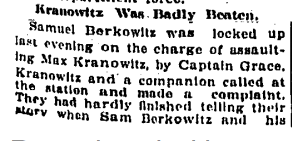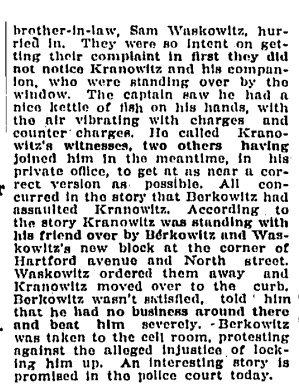Driving past New Britain, I shared the latest discoveries of the Max Crane story with my aunt and uncle. We were heading to a funeral and unfortunately had no time to explore our ancestral town. The New Britain roots trip remains in planning mode. In the meantime, as promised, the newest research developments.
Deciphering the language behind the two short newspaper clippings from 1909 left me with a nagging desire to better understand the men who beat Max. Who were they? Did meet in New Britain or perhaps in Europe? Perhaps the Kranowitz and the Waskowitz families came the same village in Russia? What went so sour between employer and employee? Who was truly to blame? Was the incident provoked by Max? How did this beating affect Max?
Up to now, I found no more mentions of Max in the newspapers—believe me, I'm looking—therefore, I took the always helpful advice of one of my readers +Jacqi Stevens and decided research the aggressors, Waskowitz and Berkowitz a bit more. Not so surprising, they made the headlines in the local papers a few more times.
Berkowitz born c. 1873 was about 34 years old during the beating and his subsequent arrest. He married to Jennie Devorah Welinksy around 1895. They had five children by 1909, the year in question. Berkowitz immigrated to America around 1889 according to US Census. He lived and ran the grocery store at the 646-648 Main Street address since at least 1898. Interestingly he lived with his brother in-law that first year the appear in the New Britain City Directory. Eventually he becomes a landlord. Owning business does involve often involves lawsuits. In 1911 Berkowitz and a partner, Nathan E. Mags, sued a tenant, a tailor, for unpaid rent. They liquidated his merchandise to pay for what he owed, but in 1914 were sued for damages by the company where he worked claiming the merchandise belong to them and not the tailor. (The Hartford Courant Feb 26, 1914). In 1921, Sam Berkowitz and the same partner were sued by a cousin, Abraham Berkowitz who claimed he was be wrongly dropped out of a partnership in a real estate deal. (The Hartford Courant, May 19, 1921). Otherwise Berkowitz stayed away from trouble and jail. Beating Max, as far as I can tell, was an isolated event.
Waskowitz, on the other hand was involved in shadier business dealings, though again, no other violent outbursts. Samuel Waskowitz, born in 1872 was about 35 the year he beat Max. He immigrated in 1888 according to his naturalization index card (Ancestry.com). He married Rebecca in 1895, according to the 1900 Census. In 1909, the year he inaugurated the Waskowitz Block, they had five children.
Waskowitz's trouble with the law made headline in 1900:
Waskowitz Has Skipped Town
 |
| The Hartford Courant (1887-1922); Sep 28, 1900 ProQuest Historical Newspapers: Hartford Courant (1764-1922) p.12 |
Now, that sounds like serious trouble! $800 in 1900, adjusted for inflation is $21,621.62 . It is hard to believe he returned to New Britain at all after skipping out on these kinds of debts. He remains listed at the same Willow Street address in the 1901 and 1902 directory indicating that perhaps the sale did not go through after all and he returned to the store and to cover his debts.
1905 brings more trouble for Waskowitz. Business was booming and he raises enough funds to beging construction on his new building. This article is of particular interest because it discusses the construction of this now infamous Waskowitz block.
Neighbors at Odds Over New Building
 | |||
| The Hartford Courant (1887-1922); Oct 11, 1905 ProQuest Historical Newspapers: Hartford Courant (1764-1922);pg. 13 |
New Britain Building Inspector Appealed To.
He Finds No Occasion to Act in the Matter
New Britain, Oct 10. There is trouble between Samuel Welinski and Samuel Waskowitz over a barn which the latter is erecting on his own land. His lot is on North Street, but the rear of the lot on which the building is being erected faces Willow Street. Mr. Welinski owns several houses on Willow street, which are provided with barns, and he is of the opinion that there are enough barns there now. He complained to the building inspector that Waskowitz was not erecting his barn according to his permit and the inspector investigated into the matter this afternoon. Mr. Bergstrom took with him L.S. Risley, chairman of the building committee and together they gave the matter careful consideration. They found the permit was being lived up to and that there was no reason, as far as the city was concerned, why Waskowitz should not go on with his building. The barn is 100 feet from the street and thirty feet from Welinski's nearest building, as the permit states. Mr. Welinski is not satisfied with this view of the matter. He says that the barn is, at most twenty-seven feet from his building , while the permit calls for thirty feet. He says that the fire risk will be increased if the barn goes up and that he is going to see a lawyer tomorrow about getting out an injunction to stop his neighbor from building. Mr. Waskowitz said this evening that Welinski wants the whole street to himself. He now keeps his horse and wagon in one of Welinski's barns and pays him $3 a month. Welinski objects he says, to anyone else in the neighborhood branching out, but wants a monopoly in the barn business. Waskowitz is in the grocery business and thinks he can save money by owning his own barn.Waskowitz and Welinski go way back! The were neighbors and grocers on Willow Street (10 and 12 respectively) since as early as 1899. I could not find a follow up article, but history tells us that Waskowitz completed his building, barn or no barn, which he inaugurated four years later, and which remains standing to this day. Just imagine obtaining a building permit in New Britain today to build a horses barn. For the first time in this processes, I have began could smell the scent of US cities in the early 1900, before the automobile and parking garages, when people housed their horses in barns throughout densely populated residencial areas.
After this major review of the local Hartford papers, I feel confident that I have some insight into the two men who assaulted Max. About fifteen years his elders and much more established than Max, a recent immigrant from the "old country". The two brother-in-laws, like Max, arrived in America in their late teens. In the seventeen year head-start they had on Max, they went from small grocery clerks to real estate entrepreneurs.
The beating incident, continues to baffle. Despite some minor shady dealings, there wasn't much there. Waskowitz may have upset some of his neighbors but he wasn't in the habit of beating people. Why had Max angered his former boss so much remains a mystery. This beating on September on 1909 most likely, caused Max to leave New Britain altogether. According to the Census, in 1910 he was boarding with the Fisher Family and working as a clerk in a grocery store in Hartford.
In case you missed earlier posts about Max Crane:
Should Genealogist Spill Family Secrets?
Mystery Monday: Max Crane
Back to Square One
Treasure Trail Heating Up Part I
Trail Heating Up Part II
Why Was Max Hanging Around the Block?







